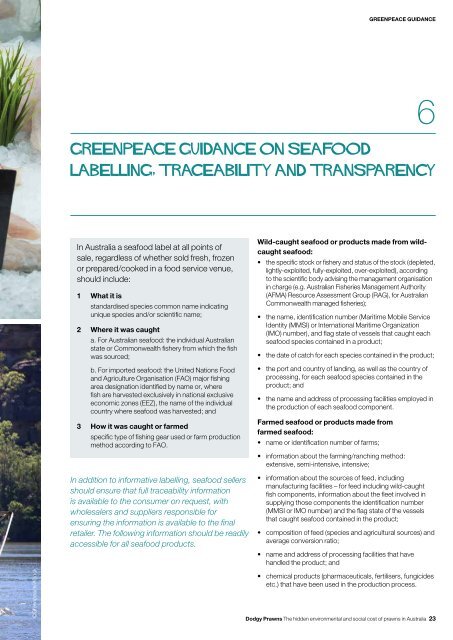Prawns
UREzh60p
UREzh60p
Create successful ePaper yourself
Turn your PDF publications into a flip-book with our unique Google optimized e-Paper software.
GREENPEACE GUIDANCE<br />
6<br />
Greenpeace guidance on seafood<br />
labelling, traceability and transparency<br />
In Australia a seafood label at all points of<br />
sale, regardless of whether sold fresh, frozen<br />
or prepared/cooked in a food service venue,<br />
should include:<br />
1 What it is<br />
standardised species common name indicating<br />
unique species and/or scientific name;<br />
2 Where it was caught<br />
a. For Australian seafood: the individual Australian<br />
state or Commonwealth fishery from which the fish<br />
was sourced;<br />
b. For imported seafood: the United Nations Food<br />
and Agriculture Organisation (FAO) major fishing<br />
area designation identified by name or, where<br />
fish are harvested exclusively in national exclusive<br />
economic zones (EEZ), the name of the individual<br />
country where seafood was harvested; and<br />
3 How it was caught or farmed<br />
specific type of fishing gear used or farm production<br />
method according to FAO.<br />
In addition to informative labelling, seafood sellers<br />
should ensure that full traceability information<br />
is available to the consumer on request, with<br />
wholesalers and suppliers responsible for<br />
ensuring the information is available to the final<br />
retailer. The following information should be readily<br />
accessible for all seafood products.<br />
Wild-caught seafood or products made from wildcaught<br />
seafood:<br />
• the specific stock or fishery and status of the stock (depleted,<br />
lightly-exploited, fully-exploited, over-exploited), according<br />
to the scientific body advising the management organisation<br />
in charge (e.g. Australian Fisheries Management Authority<br />
(AFMA) Resource Assessment Group (RAG), for Australian<br />
Commonwealth managed fisheries);<br />
• the name, identification number (Maritime Mobile Service<br />
Identity (MMSI) or International Maritime Organization<br />
(IMO) number), and flag state of vessels that caught each<br />
seafood species contained in a product;<br />
• the date of catch for each species contained in the product;<br />
• the port and country of landing, as well as the country of<br />
processing, for each seafood species contained in the<br />
product; and<br />
• the name and address of processing facilities employed in<br />
the production of each seafood component.<br />
Farmed seafood or products made from<br />
farmed seafood:<br />
• name or identification number of farms;<br />
• information about the farming/ranching method:<br />
extensive, semi-intensive, intensive;<br />
• information about the sources of feed, including<br />
manufacturing facilities – for feed including wild-caught<br />
fish components, information about the fleet involved in<br />
supplying those components the identification number<br />
(MMSI or IMO number) and the flag state of the vessels<br />
that caught seafood contained in the product;<br />
• composition of feed (species and agricultural sources) and<br />
average conversion ratio;<br />
• name and address of processing facilities that have<br />
handled the product; and<br />
©Greenpeace/Alcock<br />
• chemical products (pharmaceuticals, fertilisers, fungicides<br />
etc.) that have been used in the production process.<br />
Dodgy <strong>Prawns</strong> The hidden environmental and social cost of prawns in Australia 23


